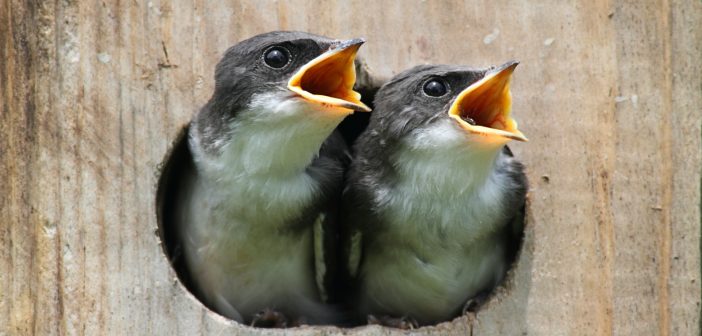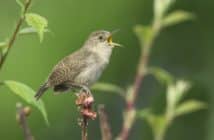Watching birds that stop by for birdseed is just half the fun of backyard birdwatching because there’s even more enjoyment to be had when you provide a birdhouse. One size doesn’t fit all birds, though. An appropriately sized and well-placed one will allow you to observe their family life, from nest-building to tending their young. You might even see the fledglings leave their nest with some luck (or a motion-activated camera).
About eighty-five species of birds in the United States nest in cavities in dead or dying trees. In cities, such trees are routinely cut down and hauled away, leaving suitable nesting options in dismally short supply. (It isn’t much better outside of town—habitat destruction is causing populations of some birds to fall.) So, providing a birdhouse (or two or three!) helps to ease their struggle.
Birds are choosy
Each species looks for a nesting place that fits a relatively narrow range of specifications. First, it must resemble, at least superficially, a cavity in a tree. The entrance hole must be large enough to enter and exit easily but small enough to make them feel hidden and safe. For example, the small opening in a wren house helps protect from predators and keeps larger birds from taking it over.
Color matters. Numerous lovely birdhouses are on the market, festooned with bright colors, ornamentation, and gadgets. But, because birds look for “trees” and camouflage, it can be harder to draw them to these. Birds, by and large, are attracted to earth tones.
You’ll find that most hardware and general merchandise stores carry birdhouses for wrens, bluebirds, Purple Martins, screech owls, and sometimes Wood Ducks. Other sources are birdseed stores and the internet. Discount stores carry inexpensive birdhouses, which usually prove to be examples of getting what we pay for: wood that’s unsuitable for long-lasting use, staples instead of screws, plastics (which don’t “breathe”), and lack of an easy opening for cleaning. What to look for in a good quality birdhouse
About thirty of the cavity-nesting species are willing to use birdhouses. This chart will help you select (or build) the correct size.
| Bird | Hole diameter (inches) | Hole placement (inches above floor) | Floor size (inches) | Sides (inches) | Feet above ground |
|---|---|---|---|---|---|
| Barn Owl | 6 | 4 | 10 x 18 | 15 x 18 | 12–18 |
| Barn Swallow | 1 or more open sides | 1 or more open sides | 6 x 6 | 6 | 8–12 |
| Bewick's Wren | 1–1¼ | 1–6 | 4 x 4 | 6 x 8 | 6–10 |
| Bluebird | 1½ | 6 | 5 X 5 | 8 | 5–10 |
| Carolina Wrren | 1½ | 1–6 | 4 x 4 | 6 x 8 | 6–10 |
| Downy Woodpecker | 1¼ | 6–8 | 4 x 4 | 8 x 10 | 6–20 |
| Flickers | 2½ | 14–16 | 7 x 7 | 16–18 | 6–20 |
| Flycatchers | 2 | 6–8 | 6 x 6 | 8–10 | 8–20 |
| Hairy Woodpecker | 1½ | 9–12 | 6 x 6 | 12–15 | 12–20 |
| House Finch | 2 | 4 | 6 x 6 | 6 | 8–12 |
| House Sparrow | 1¼–2 | 6–7 | 4 x 4 to 5 x 5 | 9–12 | 6–12 |
| House Wren | 1⅛ | 3–6 | 4 x 4 | 6–8 | 6–10 |
| Kestrel | 3 | 9–12 | 8 x 8 | 12–15 | 10–20 |
| Mourning Dove | shelf with 1 or more open sides | n/a | 12 x 12 | 9 | 12–15 |
| Nuthatch species | 1¼ | 6–8 | 4 x 4 | 8–10 | 12–20 |
| Phoebe | 1 or more open sides | 1 or more open sides | 6 x 6 | 6 | 8–12 |
| Prothonotary Warbler | 1⅛ | 4 x 5 | 5 x 5 | 6 | 4–8 |
| Purple Martins – (cluster many together or use an "apartment house") | 1¾–2¼ | 1–2 | 6 x 6 | 6 | 10–15 |
| Red-bellied Woodpecker | 2½ | 9–12 | 6 x 6 | 12–15 | 10–20 |
| Red-headed Woodpecker | 2 | 9–12 | 6 x 6 | 12–15 | 12–20 |
| Robin | 1 or more open sides | 1 or more open sides | 6 x 8 | 8 | 6–15 |
| Screech Owl | 3 | 9–12 | 8 x 8 | 12–15 | 10–20 |
| Sparrow Hawk | 3 | 9–12 | 8 x 8 | 12–15 | 10–30 |
| Titmouse species | 1¼ | 6–8 | 4 x 4 | 8–10 | 6–15 |
| Tree Swallow | 1½ | 1–5 | 5 x 5 | 6 | 10–15 |
| Wood Duck | 4 | 12–16 | 10–18 | 10–24 | 10–20 |
More reading:
Choose a birdhouse with these features in mind
No spring in the step of hungry spring birds
The plight of cavity-nesting birds






